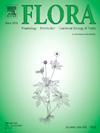标题蕨科植物柱头形态解剖特征及其分类相关性的研究
IF 1.8
4区 生物学
Q3 ECOLOGY
引用次数: 0
摘要
从19世纪到现代,蕨类植物和蕨类植物的维管排列一直是植物学家非常着迷的一个来源。茎柱解剖学的研究已被公认为具有很大的分类学价值,而蕨类植物的组织和脉管系统的模式是比较研究的一个重要方面。蕨类植物的形态解剖特征为蕨类植物的系统学和系统发育提供了重要的见解。研究了东喜马拉雅地区蕨类科24种植物的叶柄形态解剖学特征,分属蕨类亚科、vittarioidea科、cryptogrammoidea科和cheilanthoidea科4个亚科。对其茎长、颜色、表面纹理、鳞片等形态特征进行了系统的研究。同时,解剖研究揭示了茎杆轮廓、维管束形状和木质部链结构的变化。该研究强调了显着的种间变异性,维管束从U形到倒Ω形不等,木质部链采用多种形态,如V形,U形和海马形结构。这些解剖特征显示出潜在的分类学和系统发育价值,有助于物种描绘,特别是在形态特征重叠的情况下,由于趋同进化。此外,该研究证实了跨物种存在一致的厚组织表皮层,加强了这些结构在其生态位中的适应性作用。这些发现强调了柱头解剖学作为一种可靠的分类描述工具的重要性,增强了对翼科植物进化关系的理解。本文章由计算机程序翻译,如有差异,请以英文原文为准。
Investigation on the stipe morpho-anatomical traits in some members of Pteridaceae and its Taxonomic relevance
The vascular arrangement of fern and fern-allies has been a source of great fascination for botanists since the nineteenth century to modern times. The study of stipe anatomy has been accepted to be of great taxonomical value and the patterns of organization and vasculature in ferns is a great point for comparative study. The morpho-anatomical traits of fern stipes provide essential insights into fern systematics and phylogenetics. This study explores the morpho-anatomy of stipes in 24 species of Pteridaceae span under four subfamilies, Pteridoideae, Vittarioideae, Cryptogrammoideae, and Cheilanthoideae, collected from the eastern Himalayan region. The morphological traits such as stipe length, colour, surface texture, and scale characteristics were systematically examined. Concurrently, anatomical investigations revealed variations in stipe outlines, vascular bundle shapes, and xylem strand configurations.
The study highlights significant interspecific variability, with vascular bundle ranging from U to inverted Ω shaped, and xylem strands adopting diverse morphologies such as V, U, and hippocampus-shaped configurations. These anatomical traits show potential taxonomic and phylogenetic value, aiding in species delineation, particularly in cases where morphological features overlap due to convergent evolution.
Additionally, the study confirms the presence of consistent sclerenchymatous epidermal layers across species, reinforcing the adaptive role of these structures in their ecological niches. The findings emphasize the importance of stipe anatomy as a reliable tool for taxonomic delineation, enhancing the understanding of evolutionary relationships within Pteridaceae.
求助全文
通过发布文献求助,成功后即可免费获取论文全文。
去求助
来源期刊

Flora
生物-植物科学
CiteScore
3.30
自引率
10.50%
发文量
130
审稿时长
54 days
期刊介绍:
FLORA publishes original contributions and review articles on plant structure (morphology and anatomy), plant distribution (incl. phylogeography) and plant functional ecology (ecophysiology, population ecology and population genetics, organismic interactions, community ecology, ecosystem ecology). Manuscripts (both original and review articles) on a single topic can be compiled in Special Issues, for which suggestions are welcome.
FLORA, the scientific botanical journal with the longest uninterrupted publication sequence (since 1818), considers manuscripts in the above areas which appeal a broad scientific and international readership. Manuscripts focused on floristics and vegetation science will only be considered if they exceed the pure descriptive approach and have relevance for interpreting plant morphology, distribution or ecology. Manuscripts whose content is restricted to purely systematic and nomenclature matters, to geobotanical aspects of only local interest, to pure applications in agri-, horti- or silviculture and pharmacology, and experimental studies dealing exclusively with investigations at the cellular and subcellular level will not be accepted. Manuscripts dealing with comparative and evolutionary aspects of morphology, anatomy and development are welcome.
 求助内容:
求助内容: 应助结果提醒方式:
应助结果提醒方式:


